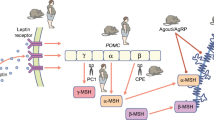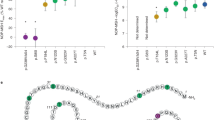Abstract
Background
The agouti yellow mouse shows adult onset of moderate obesity and diabetes. A depressed basal lipolytic rate in adipocytes or a decreased adrenergic tone arising from antagonizing α-melanocyte-stimulating hormone (MSH) activation of melanocortin receptors (MCR) could be at the origin of the obesity phenotype.
Materials and Methods
MCR 4 and 5 (MC4R, MC5R) genes were studied in the Québec Family Study. Sequence variations were detected by Southern blot probing of restricted genomic DNA, and mRNA tissue expression was detected by RT-PCR. Subjects with a wide range of weight were used for single-point sib-pair linkage studies (maximum of 289 sibships from 124 nuclear families). Analysis of variance across genotypes in unrelated males (n = 143) and females (n = 156) was also undertaken. Body mass index (BMI), sum of six skinfolds (SF6), fat mass (FM), percent body fat (%FAT), respiratory quotient (RQ), resting metabolic rate (RMR), fasting glucose and insulin, and glucose and insulin area during an oral glucose tolerance test were analyzed.
Results
MC4R showed polymorphism with NcoI, and MC5R, with PstI and PvuII, with a heterozygosity of 0.38, 0.10, and 0.20, respectively. Linkages were observed between MC5R and BMI (p = 0.001), SF6 (p = 0.005), FM (p = 0.001), and RMR (p = 0.002), whereas associations were observed in females between MC5R and BMI (p = 0.003), and between MC4R and FM (p = 0.002) and %FAT (p = 0.004). After correction for multiple tests, these p values are lowered by one tenth. MC4R and MC5R mRNAs have been detected in brain, adipose tissue, and skeletal muscle.
Conclusions
MC4R and MC5R exibit evidence of linkage or association with obesity phenotypes, but this evidence is strongest for MC5R.



Similar content being viewed by others
References
Bray GA. (1992) Pathophysiology of obesity. Am. J. Clin. Nutr. 55: 488S–494S.
Bouchard C. (1994) Genetics of obesity: Overview and research directions. In: Bouchard C (ed). The Genetics of Obesity. CRC Press, Boca Raton, FL, pp. 223–233.
Chagnon YC, Bouchard C. (1996) The genetics of obesity: Advances from rodent studies. Trends Genet. 12: 441–444.
Herberg L, Coleman DL. (1977) Laboratory animals exhibiting obesity and diabetes syndromes. Metabolism 26: 59–99.
Bultman SJ, Michaud EJ, Woychik RP. (1992) Molecular characterization of the mouse agouti locus. Cell 71: 1195–1204.
Klebig ML, Wilkinson JE, Geisler JG, Woychik RP. (1995) Ectopic expression of the agouti gene in transgenic mice causes obesity, features of type II diabetes, and yellow fur. Proc. Natl. Acad. Sci. USA 92: 4728–4732.
Mynatt RL, Miltenberger RJ, Klebig ML, Zemel MB, Wilkinson JE, Wilkison WO, Woychik RP. (1997) Combined effects of insulin treatment and adipose tissue-specific agouti expression on the development of obesity. Proc. Natl. Acad. Sci. USA 94: 919–922.
Wilson BD, Ollmann MM, Kang L, Stoffel M, Bell GI, Barsh GS. (1995) Structure and function of ASP, the human homolog of the mouse agouti gene. Hum. Mol. Genet. 4: 223–230.
Kwon HY, Bultman SJ, Löffler C, Chen W-J, Furdon PJ, Powell JG, Usala A-L, Wilkinson W, Hansmann I. (1994) Molecular structure and chromosomal mapping of the human homolog of the agouti gene. Proc. Natl. Acad. Sci. USA 91: 9760–9764.
Xu W, Reed DR, Ding Y, Price RA. (1995) Absence of linkage between human obesity and the mouse agouti homologous region (20q11.2) or other markers spanning chromosome 20q. Obes. Res. 3: 559–562.
Norman RA, Leibel RL, Chung WK, Power-Kehoe L, Chua SC Jr, Knowler WC, Thompson DB, Bogardus C, Ravussin E. (1996) Absence of linkage of obesity and energy metabolism to markers flanking homologous of rodent obesity genes in Pima Indians. Diabetes 45: 1229–1232.
Zemel MB, Kim JH, Woychik RP, Michaud EJ, Kadwell SH, Patel IR, Wilkinson WO. (1995) Agouti regulation of intracellular calcium: Role in the insulin resistance of viable yellow mice. Proc. Natl. Acad. Sci. USA 92: 4733–4737.
Kim JH, Mynatt RL, Moore JW, Woychik RP, Moustaid N, Zemel MB. (1996) The effects of calcium channel blockade on agoutiinduced obesity. FASEB J. 10: 1646–1652.
Lu D, Willard D, Patel IR, Kadwell S, Overton L, Kost T, Luther M, Chen W, Woychik RP, Wilkinson WO, Cone RD. (1994) Agouti protein is an antagonist of the melanocyte-stimulating hormone receptor. Nature 371: 799–802.
Kim JH, Kiefer LL, Woychik RP, Wilkison WO, Truedale AT, Ittoop O, Willard DH, Nichois J, Zemel MB. (1997) Agouti regulation of intracellular calcium: Role of melanocortin receptors. Am. J. Physiol. 272(Endocrinol. Metab. 35): E379–E384.
Fan W, Boston BA, Kesterson RA, Hruby VJ, Cone RD. (1997) Role of melanocortinergic neurons in feeding and the agouti obesity syndrome. Nature 385: 165–168.
Huszar D, Lynch CA, Fairchild-Huntress V, Dunmore JH, Fang Q, Berkemeier LR, Gu W, Kesterson RA, Boston BA, Cone RD, Smith FJ, Campfield LA, Burn P, Lee F. (1997) Targeted disruption of the melanocortin-4 receptor results in obesity in mice. Cell 88: 131–141.
Bouchard C. (1996) Genetic epidemiology, association and sib-pair linkage: Results from The Québec Family Study. In: Bray GA, Ryan DH (eds). Molecular and Genetic Aspects of Obesity. Louisiana State University Press, Baton Rouge, pp. 470–481.
Behnke AR, Wilmore JH. (1974) Evaluation and Regulation of Body Build and Composition. Prentice-Hall, Englewood Cliffs, NJ
Siri WE. (1976) The gross composition of the body. Adv. Biol. Med. Phys. 4: 239–280.
Himes JH, Bouchard C. (1989) Validity of anthropometry in classifying youths as obese. Int. J. Obes. 13: 183–193.
Dériaz O, Dionne F, Pérusse L, Tremblay A, Vohl M-C, Côté G, Bouchard C. (1994) DNA variation in the genes of the Na,K-adenosine triphosphatase and its relation with resting metabolic rate, respiratory quotient, and body fat. J. Clin. Invest. 93: 838–843.
Oppert JM, Nadeau A, Tremblay A, Després JP, Thériault G, Dériaz O, Bouchard C. (1995) Plasma glucose, insulin, and glucagon before and after long-term overfeeding in identical twins. Metabolism 44: 96–105.
Desbuquois B, Aurbach GD. (1971) Use of polyethylene glycol to separate free and antibody-bound peptide hormone in radioimmunoassays. J. Clin. Endocrinol. Metab. 37: 732–738.
Richterich R, Dauwalder H. (1971) Determination of plasma glucose concentration by the hexokinase-glucose-6-phosphate-dehydrogenase method (in German). Schweiz. Med. Wochenschr. 101: 601–618.
Sambrook J, Fritsch EF, Maniatis T. (1989) Molecular Cloning. A Laboratory Manual, 2nd ed., Cold Spring Harbor Laboratory Press, Cold Spring Harbor, NY, pp. 9.16–9.19.
Reed KC, Mann DA. (1985) Rapid transfer of DNA from agarose gels to nylon membranes. Nucl. Acids Res. 13: 7207–7221.
Gantz I, Miwa H, Konda Y, Shimoto Y, Tashiro T, Waston SJ, DelValle J. (1993) Molecular cloning, expression, and gene localization of a fourth melanocortin receptor. J. Biol. Chem. 268: 15174–15179.
Chhajlani V, Muceniece R, Wikberg JE. (1993) Molecular cloning of a novel human melanocortin receptor. Biochem. Biophys. Res. Commun. 195: 866–873.
Gantz I, Shimoto Y, Konda Y, Miwa H, Dickinson CJ, Yamada T. (1994) Molecular cloning, expression, and characterization of a fifth melanocortin receptor. Biochem. Biophys. Res. Commun. 200: 1214–1220.
S.A.G.E. (1994) Statistical Analysis for Genetic Epidemiology, release 2.2. Computer program package available from the Department of Biometry and Genetics, LSU Medical Center, New Orleans, LA.
Gantz I, Tashiro T, Barcroft C, Konda Y, Shimoto Y, Miwa H, Glover T, Munzert G, Yamada T. (1993) Localization of the genes encoding the melanocortin-2 (adrenocorticotropic hormone) and melanocortin-3 receptors to chromosomes 18pll.2 and 20ql3.2–ql3.3 by fluorescence in situ hybridization. Genomics 18: 166–167.
Boston BA, Cone RD. (1996) Characterization of melanocortin receptor subtype expression in murine adipose tissues and in the 3T3-L1 cell line. Endocrinology 137: 2043–2050.
Shutter JR, Graham M, Kinsey AC, Scully S, Lüthy R, Stark KL. (1997) Hypothalamic expression of ART, a novel gene related to agouti, is up-regulated in obese and diabetic mutant mice. Genes Dev. 11: 593–602.
Chowdhary BP, Gustavsson I, Wikberg JE, Chhajlani V. (1995) Localization of the human melanocortin-5 receptor gene (MC5R) to chromosome band 18p11.2 by fluorescence in situ hybridization. Cytogenet. Cell. Genet. 68: 79–81.
Acknowledgments
The authors wish to acknowledge the contribution of Guy Fournier and Lucie Allard as well as Dr. Germain Thériault for the data collection in the Québec Family Study, and François Michaud and Claude Leblanc for the management of the databases. The results of this paper were obtained in part by using the program S.A.G.E., which is supported by a U.S. Public Health Service Resource grant (1P41RR03655) from the National Center for Research Resources. This research was supported by the Medical Research Council of Canada (PG-11811).
Author information
Authors and Affiliations
Corresponding author
Additional information
Communicated by D. F. Steiner.
Rights and permissions
About this article
Cite this article
Chagnon, Y.C., Chen, WJ., Pérusse, L. et al. Linkage and Association Studies between the Melanocortin Receptors 4 and 5 Genes and Obesity-Related Phenotypes in the Québec Family Study. Mol Med 3, 663–673 (1997). https://doi.org/10.1007/BF03401705
Accepted:
Published:
Issue Date:
DOI: https://doi.org/10.1007/BF03401705




